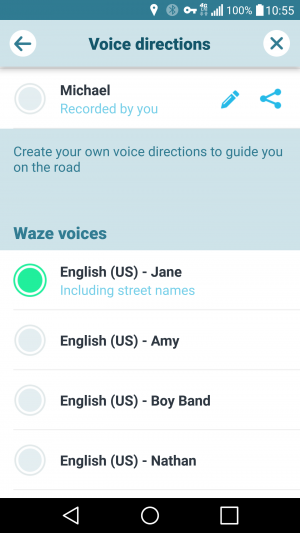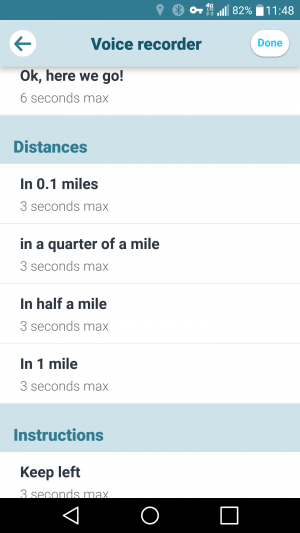When navigating in Waze with all sound turned on (rather than alerts only), Waze will issue various audible instructions at various times in order to prepare and inform the user to make a certain movement.

The occurrence, timing and format of these instructions do not depend upon the language of the voice, but they do depend upon whether the voice chosen to speak the instructions includes street names. Voices that include street names are speech synthesizers, which convert text to speech (TTS). Voices that do not include street names are simple collections of recorded phrases. We'll call these two categories of voices "TTS" and "non-TTS" respectively.
TTS
TTS voices are sophisticated speech engines, which not only say street names, but also place names and more detailed information in general regarding navigation and alerts. These include Jane, which speaks US English; Kate and Thomas, which speak UK English; and also Javier, Marusya and dozens of others in various languages.
From a TTS voice there are four possible audible instructions before a movement. Depending upon speed, distances, and timing, anywhere from one to four of these instructions may be heard.
Occurrence
We will call the different instructions A, B, C, and D based on the order they would appear. However, some instructions may not occur based on a number of conditions. The following is the order of the most common occurrence:
- D
- A, D
- A, C, D
- A, B, C, D
Instruction A
Instruction A is given a few seconds after the previous movement (or, if the previous movement is onto a ramp, a few seconds after exiting the ramp(s) onto which the previous instruction brought you), unless you are so close to the next movement that there is not enough time to give both instruction A and D (in which case only instruction D is given).
Format depends on distance to next movement.
- If distance to next movement > 4.35 mi (7.0 km), "Continue for (x hours and) y minutes to [street name]"
- If distance to next movement < 4.35 mi (7.0 km), "In [distance], [instruction] [on/to] [street name]"
| Distance to next movement | Example |
|---|---|
| > 4.35 mi (7.0 km) | Continue straight for 15 minutes to Rue Royale |
| Continue straight for 2 hours and 15 minutes to Exit 123: I-45 N / Bakerstown | |
| < 4.35 mi (7.0 km) | In 700 feet, turn left on Brightview Blvd |
| In 2.1 miles, exit to Exit 98: SR-76 / Chilltown |
Instruction B
Instruction B is given at the point where the movement is expected to be 5 minutes away, but only if it's been 15-20 minutes since instruction A.
Format: "In [x] miles, [instruction] [on/to] [street name]"
| examples |
|---|
| In 3.4 miles, turn left on Brightview Blvd |
| In 6 miles, exit right to Exit 98: SR-76 / Chilltown |
Note: while the timing of the instruction is time-based, the instruction is given in distance.
Instruction C
Instruction C is given at a certain distance from the movement depending on your speed as detected at that point, unless the prior instruction was given too close to the timing of instruction C. The street name may or may not be included, depending on how long it has been since Instruction A (a couple minutes).
Format: "In [distance], [instruction] ([on/to] [street name])"
| speed range | distance | example |
|---|---|---|
| 0 – 43.5 mph (0 – 70 km/h) | 1000 ft | In a thousand feet, turn right |
| 43.5 – 55.9 mph (70 – 90 km/h) | 0.5 mi | In half a mile, exit left |
| 55.9 – 93.2 mph (90 – 150 km/h) | 1 mi | In one mile, stay to the right to I-75 N |
| 93.2+ mph (150+ km/h) | 2 mi | In two miles, exit right |
Instruction D
Instruction D is given every time, just before the movement (unless you make the turn before Waze has a chance to call it out).
Format: "[instruction] [on/to] [street name]"
| examples |
|---|
| Turn right on Main St |
| Exit left to Exit 234B: Poydras St / Superdome |
Notes
- Instruction D is (virtually) always given.
- Instruction A is given only if there will be instruction D and there is enough time for both.
- Instruction C is given only if there was instruction A and there has been enough time since instruction A.
- Instruction B is given only if there will be instruction C (and therefore there was instruction A) and there has been enough time since instruction A.
Combined instructions
If, based on the speed of the user, Waze expects a second movement to occur within about 30 seconds after the upcoming movement, it will tack on a second instruction to the end of instructions C and D separated by "then".
| examples |
|---|
| In half a mile, exit right, then stay to the left to Exit 26: I-71 N / Cleveland |
| Turn left on N High St, then turn right on Arcadia Ave |
Preposition choice
When a voice is selected that says street names, such as Jane, those names are preceded by "on" or "to" according to a couple factors:
- Following an instruction to exit or stay to the left or right, Waze always says "to" and the street name.
- Following an instruction to turn left or right, continue straight, make a U-turn or do anything at a roundabout, Waze says either "to" or "on" dependent upon the road type of the next segment past the instruction.
- If the next segment is a Ramp , Waze says "to" and the street name.
- If the next segment is any other road type, Waze says "on" and the street name.
The word "to" at the beginning of any street name, which is common on ramp names, is never a factor in whether Waze says "to" or "on" and is actually ignored in audible instructions. This means that if the name of a ramp is inherited through an unnamed non-ramp segment, Waze will say "on" and will omit the "to" completely. For example, turning left through a roundabout made of non-ramp segments and onto a ramp with the name "to US-33 W / Lancaster" will produce the audible instruction "at the roundabout, turn left on US-33 W / Lancaster."
Flowchart
Non-TTS

Non-TTS voices are sets of recorded phrases. These include Amy and Nathan, any novelty voice like Boy Band, most other voices in other languages, and any user-recorded voices. The voice recorder contains the extent of what all non-TTS voices can say, and it is viewable in by tapping "record new voice" in the Waze voice menu.
From a non-TTS voice there are three possible audible instructions before a movement. Depending upon speed, distances, and timing, anywhere from one to three of these instructions may be heard.
First instruction
The first instruction is given when enough time and advance distance is available for it. The actual distance from the previous movement to the next movement is rounded up to give the distance used in the instruction.
Format: "In [distance], [instruction]"
| speed and/or distance to next movement | example |
|---|---|
| < 0.1 mi | In 0.1 miles, continue straight |
| 0.1 mi - 0.25 mi | In a quarter of a mile, turn right |
| 0.25 - 0.5 mi | In half a mile, at the roundabout turn left |
| 0-43.5 mph (0-70 km/h) and > 0.25 mi | |
| 43.5+ mph (70+ km/h) and > 0.5 mi | In 1 mile, make a U-turn |
Intermediate instruction
An intermediate instruction is given at a certain distance from the movement depending on your speed, unless the first instruction was given too close to the timing of the intermediate.
Format: "In [distance], [instruction]"
| Speed | Example |
|---|---|
| 0-43.5 mph (0-70 km/h) | In 0.1 miles, keep right |
| 43.5+ mph (70+ km/h) | In a quarter of a mile, exit left |
Final instruction
The final instruction is given every time, just before the movement (unless you make the turn before Waze has a chance to call it out).
Format: "[instruction]"
| Examples |
|---|
| Turn left |
| At the roundabout take the fifth exit |
Combined instructions
If, based on the speed of the user, Waze expects a second movement to occur within about 30 seconds after the upcoming movement, it will tack on a second instruction to the end of instructions C and D separated by "and then".
| Examples |
|---|
| Turn left, and then turn right |
| Exit right, and then keep left |
